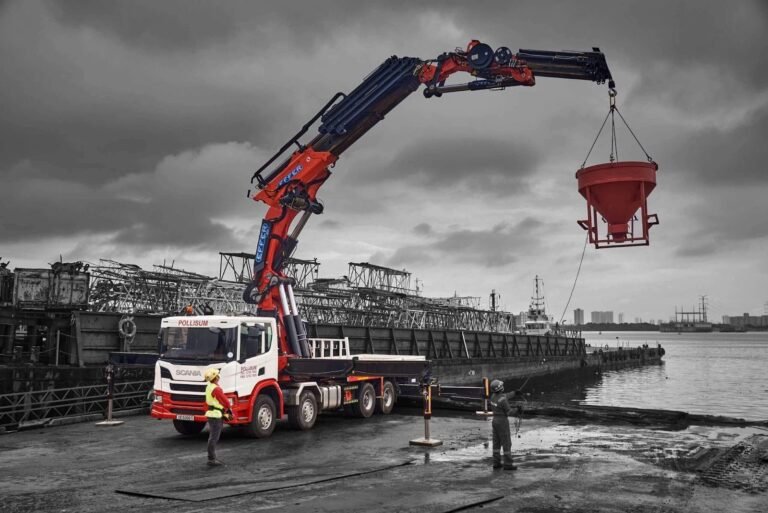Mobile truck-mounted cranes pose significant risks if their outriggers are improperly positioned or ground conditions are not properly assessed. When a tip-over occurs, a Portland truck accident lawyer can trace liability through rigging procedures, operator certifications, and safety compliance logs. These accidents often result in severe injuries and complex engineering analyses.
Understanding Truck Crane Incidents: A Growing Concern
The Rise of Incidents
In recent years, truck crane incidents have become increasingly prevalent, signaling a critical issue in the construction and logistics industries. These incidents not only pose significant safety risks but also result in substantial financial losses and operational disruptions.
The frequency of such accidents has raised alarms among industry experts and regulatory bodies, urging a reevaluation of existing safety practices. Often, these mishaps are attributed to improper stabilization, a factor frequently overlooked during operations.
Causes of Improper Stabilization
The primary cause of improper stabilization is the inadequate assessment of ground conditions before crane operation. Without a thorough evaluation, operators may inadvertently set up cranes on unsuitable surfaces, leading to instability.
Additionally, the misalignment of outriggers, essential for balancing the crane, exacerbates the risk of tipping over. Insufficient training and a lack of awareness among operators further compound the problem, underscoring the need for comprehensive education and stringent safety protocols.
Consequences of Overlooking Safety
The repercussions of ignoring stabilization requirements are manifold. First and foremost, the potential for injury or loss of life is significant, impacting not only the crane operators but also nearby workers and bystanders.
Furthermore, the financial implications are considerable, from equipment damage and repair costs to increased insurance premiums and potential legal liabilities. These incidents can also tarnish a company’s reputation, resulting in lost business opportunities and diminished stakeholder trust.
The Critical Role of Proper Stabilization in Truck Crane Safety
Understanding Stabilization Fundamentals
The foundation of truck crane safety lies in the concept of stabilization. Proper stabilization ensures that the crane remains secure and balanced during operations, preventing accidents that could lead to catastrophic failures. Truck cranes operate on various terrains and under different conditions, making stabilization a critical component in ensuring safety and efficiency.
To achieve this, operators must be well-versed in the use of stabilizers, outriggers, and counterweights, which are essential tools in maintaining equilibrium.
Common Oversights and Their Consequences
Often, the dangers of improper stabilization are overlooked, leading to incidents ranging from minor property damage to severe injuries. Common oversights include:
- Incorrect deployment of outriggers can lead to uneven weight distribution.
- Failure to account for ground conditions, such as soft soil, can cause sinking and tilting.
- Insufficient counterweight usage reduces the crane’s ability to balance loads effectively.
These oversights highlight the importance of rigorous training and adherence to safety protocols in mitigating risks associated with improper stabilization.
Effective Practices for Ensuring Stability
Implementing effective stabilization practices is paramount for safe crane operations. Operators should conduct thorough pre-operation checks to ensure all stabilization equipment is functioning correctly. Additionally, understanding the work environment, such as identifying potential hazards and evaluating soil conditions, is crucial. Key practices include:
- Regularly inspecting and maintaining stabilization equipment.
- Utilizing load charts to determine the appropriate counterweight and outrigger configurations.
- Consistently monitoring the crane’s position and stability throughout operations.
By prioritizing these practices, crane operators can significantly reduce the risk of accidents, ensuring both the safety of personnel and the longevity of equipment.
Common Causes of Improper Stabilization in Truck Cranes
Insufficient Ground Assessment
One of the primary causes of improper stabilization in truck cranes is the insufficient evaluation of ground conditions. Ground stability is crucial to crane operations, as the heavy load from the crane is transferred directly to the ground through the outriggers. If the soil is too soft, uneven, or slippery, the risk of tip-over is significantly increased. It is essential to conduct a thorough site assessment before setting up the crane.
Incorrect Outrigger Deployment
Incorrect outrigger deployment often leads to improper stabilization, making this another critical factor in crane incidents. Outriggers must be fully extended and properly placed on stable ground to counterbalance the crane’s load effectively. Operators sometimes fail to extend outriggers completely or place them on uneven surfaces, compromising stability.
Inadequate Operator Training and Awareness
Inadequate training and lack of operator awareness are significant contributors to improper stabilization. Operators must be well-versed in crane dynamics, including load charts and the impact of load movement on stability.
Without adequate training, operators may misjudge the crane’s capacity or fail to recognize the signs of instability. Regular training programs and refresher courses are essential to ensure operators are equipped with the latest safety practices and understand the critical importance of proper stabilization techniques.
Final Thoughts
Understanding the critical role of proper stabilization in truck crane operations is not just a matter of regulatory compliance but a pivotal aspect of ensuring safety on worksites. As you navigate the complexities of crane operations, prioritize thorough training and adherence to safety protocols to mitigate risks.
In the event of an incident, consulting a Portland truck accident lawyer can help you understand your legal options and responsibilities. By fostering a culture of vigilance and responsibility, you can significantly reduce the incidence of accidents, protecting both personnel and equipment.
